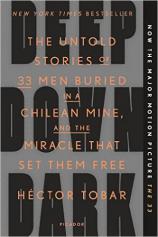Reading Group Guide
Discussion Questions
Deep Down Dark: The Untold Stories of 33 Men Buried in a Chilean Mine, and the Miracle That Set Them Free

1. The prologue to DEEP DARK DOWN describes the incredibly long commutes made by employees to reach the remote San José Mine. No local jobs paid as well, so the pay was an incentive for miners such as Franklin Lobos, signing on at age 52 to help pay his daughter’s college tuition. Jessica Chilla refused to kiss Darío Segovia goodbye on the morning of August 5th because he chose the high pay despite the dangers, and because the job would cause them to postpone their daughter’s birthday party. What risks and personal sacrifices would you be willing to endure for a high wage?
2. Carlos Pinilla, the general manager of the San Esteban Mining Company, had a mandate from the owners to cut costs but keep the mine running, despite government threats of shutdown in 2007 in the wake of a deadly accident. Yet the mine continued to operate without key safety features, such as ladders in the vertical escape tunnels. Manuel Gonzáles, the first rescuer to reach the miners, was shocked by the primitive gear San Estaban had issued its workers. How would you have handled Pinilla’s dilemma?
3. What new information did you gain about those 69 days of survival? What details did DEEP DARK DOWN provide that were absent from the 2010 media blitz?
4. Discuss the many types of hunger described in the book, starting of course with hunger for food. Would you have been a food-box looter, or would you have complied with Mario Sepúlveda’s calculations? What did you learn about the physiology of starvation, and the dangerous process of refueling an emaciated body? What other cravings did the miners face, deprived of power, their families and a way out? What would your coping strategies have been?
5. As their bodies became diminished, what happened to the miners’ approach to spirituality and mortality (the focus of Chapter 15, “Saints, Statues, Satan”)? How did tangible objects --- culminating in the arrival of a carved Virgin Mary --- enhance their prayers?
6. The closing line of Chapter 9, “Cavern of Dreams,” is a quote from José Henríquez, the informal pastor, after the pipe and drill bit broke through: “‘Dios existe,’ he says. God exists.” Do you attribute the rescue to human ingenuity, divine intervention, or a combination of the two? What is your definition of a miracle?
7. Discuss the women’s perspectives, especially focusing on Chapter 3, “The Dinner Hour,” and the tent city of Camp Esperanza, where María Segovia (sister of Darío) became the unofficial mayor? As Ariel Ticona watches a video of his daughter’s birth, what new point of view does he gain regarding his wife?
8. Throughout the central chapters, we watch the process of “mining” for men, as the world’s leading drillers (Jeff Hart in particular) are called in to break through the earth. DEEP DARK DOWN also describes the process of extracting gold and copper at the San José Mine. How did the book affect your view of humankind versus nature? How did the drilling images compare to the image of Edison Peña running through the tunnels of the mine?
9. Discuss the political power struggles over who would to become the face of the rescue (especially President Sebastián Piñera versus the minister of mining, Laurence Golborne). How did the psychologist Alberto Iturra handle the limitations of his power? How did the miners manage the question of leadership throughout their ordeal, eventually delegating duties (including nursing and communications)?
10. The rescue is a triumph of many elements, especially engineering and global cooperation. The book introduces us to experts from NASA, the military, the mining industry, and other sectors, hailing from Kansas, South Africa, Austria, Italy, and other corners of the globe, culminating in the safe dispatch of the Fénix. The miners themselves demonstrated tremendous skill and ingenuity. What would it take to harness that level of visionary cooperation for other global crises?
11. From the millionaire Leonardo Farkas’s fund to the miners’ decision to form Propiedad Intelectual Minera, S.A. (Miner Intellectual Property, Inc.), how has the miners’ financial well-being been dealt with? Did it surprise you that not all of the miners accepted pensions?
12. In the aftermath of the rescue, some of the men return to mining, despite terrifying flashbacks. Víctor Zamora, who was difficult for the author to track down, was once homeless and returns to a broken and destitute life. Edison Peña battles alcoholism. Others celebrate fatherhood, while still others focus on capitalizing on their experience. What determines whether survivors can find meaning in their lives, sustained by hope?
13. How did the miners retain their individuality while they were trapped? Which of their personal stories resonated with you the most?
14. How does DEEP DARK DOWN enhance the images of humanity that Héctor Tobar has presented in his previous books (TRANSLATION NATION and the novels THE BARBARIAN NURSERIES and THE TATTOOED SOLDIER)? How did his training as a journalist and a novelist --- combined with his roots in Central America --- prepare him to capture the miners’ stories?
Deep Down Dark: The Untold Stories of 33 Men Buried in a Chilean Mine, and the Miracle That Set Them Free
- Publication Date: September 1, 2015
- Genres: Biography, Nonfiction
- Paperback: 336 pages
- Publisher: Picador
- ISBN-10: 1250074851
- ISBN-13: 9781250074850








